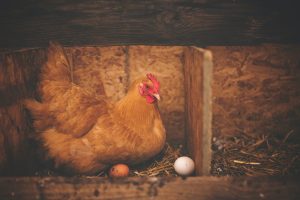How to Combat Coccidiosis in Poultry
Coccidiosis in poultry is still considered as one of the main diseases affecting the performance of poultry birds reared under the intensive system of management. Coccidiosis is a common disease in poultry and it is prevalent among different kinds of livestock animals, even though it is species-specific. Coccidiosis in poultry is characterized by enteritis and bloody diarrhoea. Coccidiosis is caused by protozoa of the phylum Apicomplexa, family Eimeriidae. In poultry, most species belong to the genus Eimeria and infect various sites in the intestine. The infectious process is rapid (4–7 days) and is characterized by parasite replication in host cells with extensive damage to the intestinal mucosa.

Causes of coccidiosis in poultry
Coccidiosis is a disease that is caused by protozoan parasites of the genus Eimeria, developing within the intestine of most domestic and wild animals and birds. Seven species of Eimeria (E. acervulina, E. brunetti, E. maxima, E. mitis, E. necatrix, E. praecox and E. tenella) are recognized as infecting chickens. Although coccidiosis is a disease known for many years, it is still considered as the most economically important parasitic condition affecting poultry production worldwide. All birds carry the coccidia organism in their guts but only some will develop the disease. The disease starts with an unsporulated oocyst, which is passed through the bird’s faeces. An unsporulated oocyst can lay dormant in the soil for up to a year and doesn’t sporulate (become infectious) unless it gets the opportunity to sit for several days in wet and humid conditions, for example, in and around waterers and feeders that is not properly cleaned
When the bird eats a sporulated oocyst, either through contaminated water, feed or during its usual scratching around the pen, the digestive acids of the chicken’s intestines will break down the hard protective layer of the oocyst. The oocyst will hatch and invade the cell lining in the small intestine. The parasite goes through several life stages, multiplying inside the bird and at each stage rupturing more cells within the gut, resulting in ulceration.
The coccidia oocyst will be expelled in the bird’s faeces and can then go on to cause infection to your other birds if they eat the faeces.
Transmission of coccidiosis in poultry Birds.
The oocysts are resistant to environmental stress and disinfectants, they remain viable in the litter for many months. Temperatures above 56˚C and below 0˚C are lethal but it seems to be impossible to decontaminate a previously contaminated poultry house or the environment. Sporulated oocysts can be spread mechanically by wild birds, insects or rodents and via contaminated feeds, boots, clothing, equipment or dust. Direct oral transmission is the natural route of infection.
Symptoms of coccidiosis in poultry.
The incubation period of coccidiosis is about eight days. Symptoms can either be gradual or sudden. The most common symptom you might notice is blood or mucus in the droppings of the birds. Most birds are affected between the ages of 3 and 5 weeks old. While it can affect any chicken at any age, most chickens are immune to coccidia by the time they’re 14 weeks old. Common symptoms include:
• Weakness
• Huddling together as if cold
• Pale comb and skin
• loss of appetite
• Ruffled feathers
• Weight loss
• Poor weight gain
• bloody diarrhoea
All these symptoms could be as a result of other diseases, so the only way to know for sure that you’re dealing with coccidiosis is to call your veterinarian.
Clinical signs of coccidiosis in Birds
Clinical signs observed during post-mortem of bird infected with coccidiosis include the following:
• Thin, fragile, often translucent intestinal walls,
• ballooning of the gut,
• Hyperaemia of the mesenteric blood vessels and blood vessels on the serosal side of the intestine,
• Flaccid gut edges after incision, lack of tonus
• Watery or foamy contents,
• Poorly digested feed particles at the end of the gastrointestinal tract (GIT)
• Multi-coloured oily aspect of the gut contents in contact with the mucosa
Prevention and control of coccidiosis in poultry.
The best way to prevent and control coccidiosis in poultry is to avoid it by being an observant farmer and maintaining a high degree of biosecurity practices in the farm. Few management practices that can help control coccidiosis in poultry:
• Coccidia oocyst needs wet, warm, and humid conditions to thrive. Keep feeding and watering areas dry always and clear out litters and droppings regularly
• Coccidiosis will spread fast in overcrowded conditions
• Blood in droppings, weakness of birds, loss of appetite, if you see any of these warning signs the sooner you act the better chance your birds have for survival
• Younger birds are more at risk, consider providing medicated starter feed for chicks
• Amprolium drugs are the normal treatment, but can also be used as a preventive drug
• Anticoccidial drugs can be mixed with their feed to limit high levels of infection.
• Keep bedding clean and dry
Treatment of coccidiosis in poultry
Amprolium drugs are commonly used in the treatment of coccidiosis or drugs with sulfaquinoxaline as their active ingredients.
Organic way of treating coccidiosis in poultry
• Coccidiosis in poultry can be prevented using crushed pawpaw seeds. Three grams of the powdered pawpaw seed for every kg of live weight. To treat coccidiosis with the powdered pawpaw seed, it requires a higher dose for a long period of time. The crushed pawpaw seed can be mix in chicken feed or water.
• Garlic can also be squeezed into their water as preventive or curative measures.
Conclusion
Infections with coccidia are often associated with severe economic losses. Currently, the prevention and control of coccidiosis are based on good hygiene, biosecurity measures chemotherapy (Coccidiostats). Generally, anticoccidial drugs alone is of little value, unless they are complemented by improvements in all aspects of poultry management. More attention should be given to improved sanitation and hygiene of the farm.
